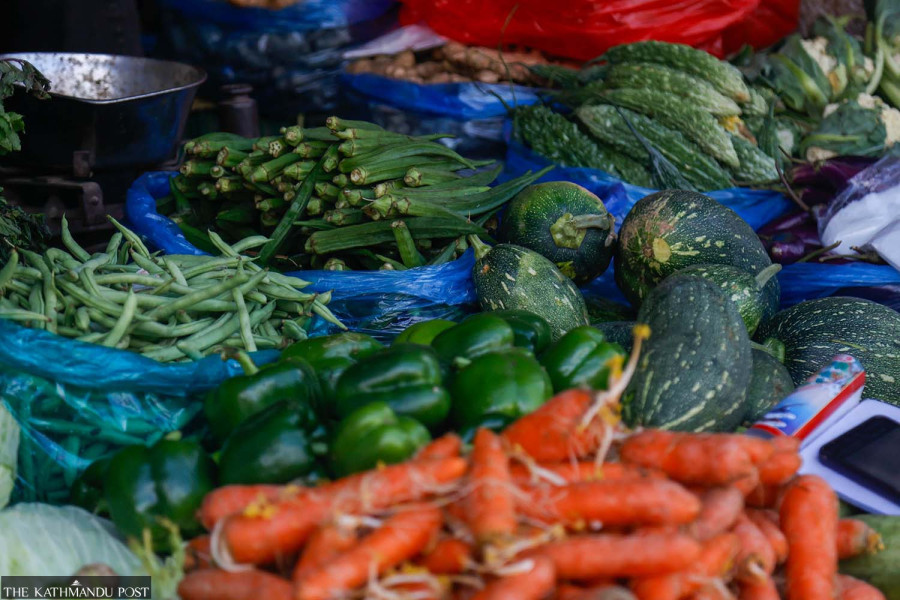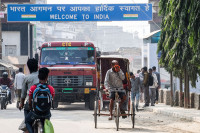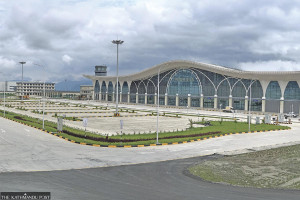National
Heavy rains and road closures push vegetable prices up in Kathmandu Valley
As of Sunday afternoon, Kalimati vegetable market received only around 58 tonnes of vegetables. The daily requirement of Kathmandu Valley is 700 tonnes.
Post Report
Vegetable prices in Kathmandu Valley have surged again as continuous rainfall, floods, and landslides have disrupted supply routes to the capital.
The situation worsened on Saturday when heavy downpours completely halted transport, creating a sharp spike in retail prices amid the ongoing festive season.
Traders said prices are likely to remain high until the supply chain returns to normal, winter vegetables begin arriving in the market, and the Dashain festivities conclude.
The torrential rain that started Friday night caused extensive damage to transport infrastructure across multiple regions, with landslides cutting off major highways in several places.
Citing worsening weather forecasts, the government on Saturday decided to close all major highways connecting Kathmandu for three days, until Tuesday, and declared nationwide public holidays.
Although some roads have partially reopened, vehicle movement remains restricted as authorities monitor landslide-prone sections.
According to the Kalimati Fruits and Vegetable Market Development Board, wholesale prices of green vegetables rose by up to 134 percent on Sunday.
The market received only 312 tonnes of vegetables on Saturday—less than half of the normal daily supply of around 700 tonnes.
Kathmandu’s vegetable demand is largely met by supplies from neighbouring districts like Dhading, Chitwan, Makawanpur, and Kavrepalancok, along with the Tarai.
Even slight disruptions on these routes immediately affect the Valley’s food supply.
Data from the Kalimati board showed that wholesale prices of several vegetables have increased significantly within a month.
Items such as potato, onion, carrot, cabbage, cauliflower, eggplant, French beans, bitter gourd, pointed gourd, sponge gourd, pumpkin, okra, leafy greens, mushrooms, and green chillies have all become more expensive.
While wholesale traders say prices at Kalimati have not risen drastically considering the current supply crunch, retail prices have jumped sharply.
For instance, the wholesale price of cauliflower on Sunday was Rs95 per kg, but in retail markets across the Valley, the same vegetable was selling for as high as Rs160 per kg.
“Cauliflower at Rs100 per kg in wholesale is reasonable given the gap between demand and supply,” said Binaya Shrestha, information officer at the Kalimati board.
“But we’ve heard that retailers are charging a high profit margin, which is why prices are soaring at the consumer level.”
As of Sunday afternoon, Kalimati had received only around 58 tonnes of vegetables.
“We heard that the Prithvi Highway has reopened, so we expect more supplies to arrive from Sunday evening,” Shrestha added.
According to Nepal Rastra Bank, year-on-year consumer price inflation stood at 1.68 percent in mid-August 2025, compared to 4.09 percent a year ago.
Food and beverage inflation was recorded at -2.28 percent, while non-food and service inflation stood at 3.95 percent.
Vegetable prices, the report said, had declined by 18.56 percent during that period.
However, consumers like Jayaram Maharjan from Nakkhu find such statistics far removed from reality.
“Vegetable prices never really go down,” Maharjan said. “Even when officials claim they’ve fallen, they always remain high.”
Maharjan said he recently bought two kg of cauliflower for Rs340 and one kg of bitter gourd for Rs125 from a local grocery store.
“I spent nearly Rs500 on just two vegetables. Do you think I’d believe the central bank’s data?” he said.
Traders said demand for vegetables such as cauliflower, tomato, cucumber, white radish, and carrot remains particularly high during the Dashain tika period, putting further pressure on prices.
According to Kalimati’s data, the wholesale price of large tomatoes has declined slightly—by 2.6 percent in a month—to Rs75 per kilogram, but retail prices range between Rs140 and Rs150 per kilogram.
Local carrots are priced at Rs125 per kg wholesale, up 8.7 percent, while Terai-grown carrots have risen by 14.58 percent to Rs110 per kg.
In retail, carrots cost Rs140–150 per kg.
Cabbage prices have more than doubled, rising by 102.13 percent to Rs95 per kilo.
Brinjal is up 13.64 percent to Rs25 per kg, while round brinjal (eggplant) has fallen 13.58 percent to Rs35 per kg—but retail rates hover between Rs90 and Rs100 per kg.
The wholesale price of long French beans has increased by 15.79 percent to Rs110 per kg, and the hybrid variety by 29.41 percent to Rs110 per kg.
Bitter gourd prices are up 14.04 percent to Rs65 per kg wholesale, but cost Rs110–120 per kilogram in retail markets.
With major highways still only partially open and the festival season extending demand, traders warn that consumers may continue to face high vegetable prices in the coming days.




 18.12°C Kathmandu
18.12°C Kathmandu














